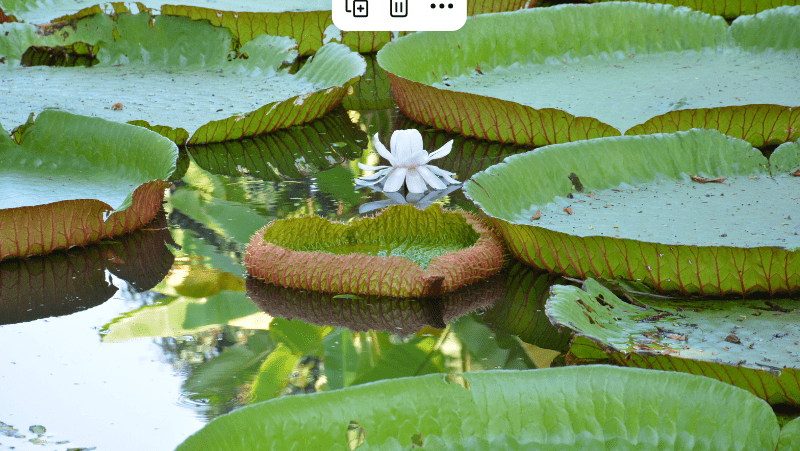
The Majestic Victoria Water Lily: Nature’s Floating Giant

Introduction
The Victoria water lily, a marvel of the natural world, is one of the most extraordinary aquatic plants known for its enormous floating leaves and beautiful blooms. Native to the Amazon basin, this plant is a symbol of botanical grandeur and a point of fascination for horticulturists and nature lovers alike. In this blog post, we’ll dive deep into the world of the Victoria water lily, exploring its characteristics, ecological significance, and interesting facts, supported by statistics, analytics, and visual grids to enhance your understanding.
The Victoria Water Lily: An Overview
| Botanical Name | Victoria amazonica |
|---|---|
| Family | Nymphaeaceae |
| Native Region | Amazon Basin, South America |
| Leaf Diameter | Up to 3 meters (10 feet) |
| Flower Size | Up to 40 cm (15 inches) in diameter |
| Blooming Season | November to March |
The Victoria water lily is the largest of its kind, with leaves that can reach up to 3 meters in diameter, capable of supporting weights up to 65 kg (143 lbs). Its flowers, which open in the evening, are initially white and turn pink or red by the next night, adding to its mystique.
Ecological Importance
The Victoria water lily plays a significant role in its native ecosystem. The large leaves provide shelter and habitat for various aquatic organisms, while the plant’s presence influences the water temperature and light penetration, affecting the overall health of the aquatic environment.
Key Ecological Roles:
- Habitat Creation: The leaves provide a habitat for fish, insects, and other aquatic life.
- Oxygen Production: As with other aquatic plants, Victoria water lilies contribute to the oxygenation of water bodies, which is crucial for the survival of other organisms.
- Water Temperature Regulation: The extensive coverage of water bodies by its leaves can help in regulating the temperature, maintaining a stable aquatic environment.
Global Distribution & Cultivation
| Continent | Countries | Notable Locations |
|---|---|---|
| South America | Brazil, Bolivia, Guyana, Peru | Amazon Basin, Pantanal |
| North America | USA | Missouri Botanical Garden, Phipps Conservatory |
| Europe | United Kingdom, France | Royal Botanic Gardens, Kew, Jardin des Plantes |
| Asia | India, Japan, China | Kolkata Botanical Garden, Shanghai Botanical Garden |
| Australia & Oceania | Australia | Royal Botanic Gardens, Sydney |
While native to South America, the Victoria water lily has been cultivated worldwide in botanical gardens and private collections. The plant requires specific conditions to thrive, including warm temperatures, ample sunlight, and large, shallow water bodies.
Cultural and Historical Significance
The Victoria water lily holds a special place in history and culture. Named after Queen Victoria of the United Kingdom, the plant was first discovered in 1801 and became a symbol of the British Empire’s botanical exploration.
Historical Timeline:
| Year | Event |
|---|---|
| 1801 | First discovered in the Amazon Basin by Tadeáš Haenke. |
| 1837 | Named Victoria regia in honor of Queen Victoria by John Lindley. |
| 1849 | Successfully cultivated in England at the Royal Botanic Gardens, Kew. |
| 1851 | Featured at the Great Exhibition in London, becoming a symbol of empire. |
Interesting Facts & Trivia
- Floating Giant: The Victoria water lily’s leaves are the largest of any water lily, capable of supporting a small child.
- Nocturnal Blooms: The flowers open at night and emit a sweet, pineapple-like fragrance to attract beetle pollinators.
- Color Change: The flowers change color from white to pink or red, a phenomenon linked to their reproductive cycle.
- Pollination Process: The plant’s flowers are thermogenic, generating heat to attract beetles, which play a crucial role in its pollination.
Challenges and Conservation Efforts
The Victoria water lily faces threats from habitat destruction, pollution, and climate change. Conservation efforts are focused on protecting its natural habitats and ensuring the survival of this botanical wonder.
Conservation Status:
| Threats | Impact | Conservation Actions |
|---|---|---|
| Habitat Loss | Decline in natural populations | Protected areas in Amazon Basin |
| Climate Change | Altered water levels and temperatures | Climate resilience research |
| Pollution | Water quality degradation | Pollution control and awareness programs |
Conclusion
The Victoria water lily is more than just a botanical curiosity; it is a testament to nature’s ability to create awe-inspiring beauty and intricate ecological systems. Whether you’re a gardener, botanist, or nature enthusiast, understanding and appreciating the Victoria water lily can deepen your connection to the natural world.
By highlighting its significance, ecological roles, and conservation challenges, this blog post aims to spread awareness and encourage efforts to preserve this incredible species for future generations.
With its blend of history, science, and aesthetic appeal, the Victoria water lily truly stands as one of nature’s most remarkable creations.
Hello, I am Aman (: Full Time Traveler :) At the age of 41, in April 2023, fueled by my love for travel and the determination not to remain fixed like a tree, I embarked on a bold journey. Having dedicated 17 years to a corporate job, I chose to transition from a full-time employee to a full-time traveler, driven by the desire to break free from the routine and constraints of a conventional life. Along the way, I not only explored the wonders of travel but also uncovered the transformative power of financial freedom. I realized how it could liberate me to lead a life teeming with adventure, purpose, and fulfillment. Through my blogs, I am passionately sharing my story, aiming to inspire and provide valuable guidance to those, like me, who aspire to weave travel into a life overflowing with limitless possibilities.





















Post Comment
You must be logged in to post a comment.